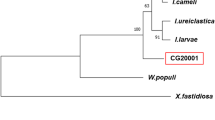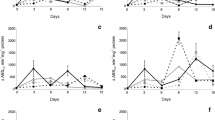Abstract
We evaluated phytohormone and polyamine biosynthesis, siderophore production, and phosphate solubilization in two strains (Cd and Az39) of Azospirillum brasilense used for inoculant formulation in Argentina during the last 20 years. Siderophore production and phosphate solubilization were evaluated in a chemically defined medium, with negative results. Indole 3-acetic acid (IAA), gibberellic acid (GA3), and abscisic acid (ABA) production were analyzed by gas chromatography-mass spectrometry. Ethylene, polyamine, and zeatin (Z) biosynthesis were determined by gas chromatography-flame ionization detector and high performance liquid chromatography (HPLC-fluorescence and -UV), respectively. Phytohormones IAA, Z, GA3, ABA, ethylene, and growth regulators putrescine, spermine, spermidine, and cadaverine (CAD) were found in culture supernatant of both strains. IAA, Z, and GA3 were found in all two strains; however, their levels were significantly higher (p < 0.01) in Cd (10.8, 2.32, 0.66 μg ml−1). ABA biosynthesis was significantly higher (p < 0.01) in Az39 (0.077 μg ml−1). Ethylene and polyamine CAD were found in all two strains, with highest production in Cd cultured in NFb plus l-methionine (3.94 ng ml−1 h−1) and Az39 cultured in NFb plus l-lysine (36.55 ng ml−1 h−1). This is the first report on the evaluation of important bioactive molecules in strains of A. brasilense as potentially capable of direct plant growth promotion or agronomic yield increase. Az39 and Cd showed differential capability to produce the five major phytohormones and CAD in chemically defined medium. This fact has important technological implications for inoculant formulation as different concentrations of growth regulators are produced by different strains or culture conditions.



Similar content being viewed by others
References
Aziz A, Martin-Tanguy J, Larher F (1997) Plasticity of polyamine metabolism associated with high osmotic stress in rape leaf discs and with ethylene treatment. Plant Growth Regul 21:153–163
Bashan Y, Holguin G (1997) Azospirillum–plant relationships: environmental and physiological advances. Can J Microbiol 43:103–121
Bashan Y, Holguín G (1998) Proposal for the division of plant growth-promoting rhizobacteria into two classifications: biocontrol-PGPB (plant growth promoting bacteria) and PGPB. Soil Biol Biochem 30:1225–1228
Bashan Y, Levanony H (1990) Current status of Azospirillum inoculation technology: Azospirillum as a challenge for agriculture. Can J Microbiol 36:591–608
Bashan Y, Holguin G, de-Bashan L (2004) Azospirillum–plant relationships: physiological, molecular, agricultural, and environmental advances (1997–2003). Can J Microbiol 50:521–577
Bottini R, Fulchieri M, Pearce D, Pharis R (1989) Identification of gibberellins A1, A3, and Iso-A3 in cultures of A. lipoferum. Plant Physiol 90:45–47
Cassán F, Paz R, Maiale S, Masciarelli O, Vidal A, Luna V, Ruíz O (2005) Cadaverine production by Azospirillum brasilense az39. A new plant growth promotion mechanism. XV Annual Meeting Cordoba Biology Society, Argentina, p 10
Crozier A, Arruda P, Jasmim JM, Monteiro AM, Sandberg G (1988) Analysis of indole-3-acetic acid and related indoles in culture medium from Azospirillum lipoferum and Azospirillum brasilense. Appl Environ Microbiol 54:2833–2837
Dobbelaere S, Croonenborghs A, Thys A, Vande Broek A, Vanderleyden J (1999) Phytostimulatory effect of Azospirillum brasilense wild type and mutant strains altered in IAA production on wheat. Plant Soil 212:155–164
Döbereiner J, Pedroza F (1987) Nitrogen-fixing bacteria in nonleguminous crop plants. Science Tech, Madison, WI, pp 1–155
Döbereiner J, Marriel I, Nery M (1976) Ecological distribution of Spirillum lipoferum Beijerinck. Can J Microbiol 22:1464–1473
Hamana K, Matsuzaki S, Sakakibara M (1988) Completar. Int J Syst Bacteriol 38:89–98
Horemans S, Koninck K, Neuray J, Hermans R, Vlassak K (1986) Production of plant growth substances by Azospirillum sp. and other rhizophere bacteria. Symbiosis 2:341–346
Janzen R, Rood S, Dormar J, McGill W (1992) Azospirillum brasilense produces gibberellins in pure culture and chemically-medium and in co-culture on straw. Soil Biol Biochem 24:1061–1064
Katznelson H, Bose B (1959) Metabolic activity and phosphate-dissolving capability of bacterial isolates from wheat roots, rhizosphere, and non-rhizosphere soil. Can J Microbiol 5:79–85
Kolb W, Martin P (1985) Response of plant roots to inoculation with Azospirillum brasilense and to application of indoleacetic acid. In: Klingmüller W (ed) Azospirillum III: genetics, physiology, ecology. Springer, Berlin, pp 215–221
Kovats E (1958) Gas chromatographische charakteriserung organischer verbindungen I. Retentions indices aliphatischer halogenide, alkohole, aldehyde und ketone. Helv Chim Acta 41:1915–1932
Niemi K, Häggman H, Sarjala T (2002) Effects of exogenous diamines on the interaction between ectomycorrhizal fungi and adventicius root formation in Scots pines in vitro. Tree Physiol 22:373–381
Okon Y, Labandera-González C (1994) Agronomic applications of Azospirillum: an evaluation of 20 years worlwide field inoculation. Soil Biol Biochem 26:1591–1601
Pan B, Bai Y, Leibovitch S, Smith D (1999) Plant-growth-promoting rhizobacteria and kinetin as ways to promote corn growth and yield in a short-growing-season area. Eur J Agron 11:179–186
Peck S, Kende H (1995) Sequential induction of the ethylene biosynthetic enzymes by indole-3-acetic acid in etiolated peas. Plant Mol Biol 28:298–301
Ribaudo C, Krumpholz E, Cassán F, Bottini R, Cantore M, Curá A (2006) Azospirillum sp. promotes root hair development in tomato plants through a mechanism that involves ethylene. J Plant Growth Regul 24:175–185
Saxena B, Modi M, Modi V (1986) Isolation and characterization of siderophores from Azospirillum lipoferum D-2. J Gen Microbiol 132:2219–2224
Schwyn B, Neilands J (1987) Universal assay for detection and determination of siderophores. Anal Biochem 160:47–56
Seshadri S, Muthukumarasamy R, Lakshinarasimhan C, Ignacimuthu S (2000) Solubilization of inorganic phosphates by Azospirillum halopraeferans. Curr Sci 79:565–567
Strzelczyk E, Kamper M, Li C (1994) Cytocinin-like-substances and ethylene production by Azospirillum in media with different carbon sources. Microbiol Res 149:55–60
Thuler D, Flosh E, Handro W, Barbosa M (2003) Plant growth regulators and amino acids released by Azospirillum sp. in chemically defined medium. Lett Appl Microbiol 37:174–178
Tiburcio AF, Altabella T, Borrell A, Masgrau C (1997) Polyamine metabolism and its regulation. Physiol Plant 100:664–674
Tien TM, Gaskins MH, Hubbell DH (1979) Plant growth substances produced by Azospirillum brasilense and their effect on the growth of pearl millet (Pennisetum americanum L.). Appl Environ Microbiol 37:1016–1024
Acknowledgments
We are grateful to Consejo Nacional de Investigaciones Científicas y Técnicas (CONICET), Secretaría de Ciencia y Técnica de la Universidad Nacional de Río Cuarto, and Nitragin Argentina SA for their support in this research.
Author information
Authors and Affiliations
Corresponding author
Rights and permissions
About this article
Cite this article
Perrig, D., Boiero, M.L., Masciarelli, O.A. et al. Plant-growth-promoting compounds produced by two agronomically important strains of Azospirillum brasilense, and implications for inoculant formulation. Appl Microbiol Biotechnol 75, 1143–1150 (2007). https://doi.org/10.1007/s00253-007-0909-9
Received:
Revised:
Accepted:
Published:
Issue Date:
DOI: https://doi.org/10.1007/s00253-007-0909-9




